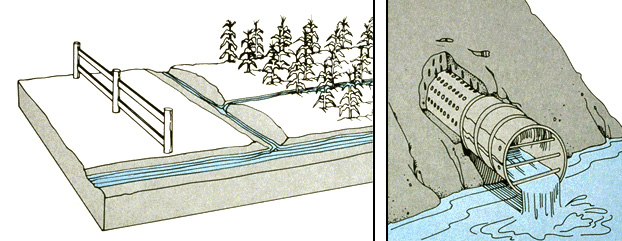Drainage, in agriculture, is the removal of excess water that is on or beneath the surface of the soil. Most plants do not grow well in soil that is saturated with water. Usually, water drains naturally from the soil. The water runs off, evaporates, is absorbed by the soil, or used by plants. In areas that do not drain naturally, artificial drainage systems may be used to aid plant growth. Drainage systems are also used to make soil suitable for other purposes, including the construction of buildings and highways. 
Excess water may collect on or in soil from rainfall, irrigation, or underground sources. Soils require drainage if they have water standing on their surface or if water fills the spaces between the soil particles. Soils also need to be drained if the area has a high water table. The water table is the topmost level of a zone of saturated soil. In soils that do not drain properly, the water table may be close to or at the surface. A high water table limits the growth of most plant roots or causes them to rot. A drainage system lowers the water table, allowing air to enter the soil so plants can grow normally.
In irrigated areas, drainage systems may serve another purpose. Most irrigation water contains salts. After plants use this water, the salts remain in the soil. If allowed to collect, salts can reduce or prevent plant growth. Drainage systems carry away or dissolve out these salts.
There are two main types of drainage systems–surface drainage and subsurface drainage. Both systems carry excess water to a suitable outlet, such as a pond or stream. A third system drains soil by means of wells and pumps. This system is usually too costly.
Surface drainage
is used in areas that are flat, have much rainfall, and collect water rapidly. Surface drainage is also used to drain fine-textured soils, such as silts and clays, which do not absorb water quickly. Surface drainage systems may consist of shallow channels or deep ditches. These systems reduce the need for subsurface drainage, which costs more than surface drainage.
Shallow channels can be dug in random patterns along low areas where water runs naturally. Ditches may be used in large, flat areas. They may be dug to a depth of 3 to 6 feet (0.9 to 1.8 meters) in a parallel pattern. The ditches drain excess water from the surface or a high water table. However, the ditches obstruct the movement of human beings, machines, and animals. In addition, they take up farmland and may accumulate weeds.
Subsurface drainage
lowers high water tables. A subsurface system may use a series of buried tubes, pipes, or tiles. Plastic tubes or clay pipes may have small holes through which water enters the system. Drainage tiles consist of 12-inch (30-centimeter) clay pieces that are placed end to end. Water enters through the spaces between tiles. Gravel may be placed around the tubes, pipes, or tiles to prevent soil from entering and plugging the system.
The tubes, pipes, or tiles measure 4 to 30 inches (10 to 75 centimeters) in diameter. They are buried 30 to 600 feet (9 to 180 meters) apart and 3 to 8 feet (0.9 to 2.4 meters) deep. The cost of laying the system increases with depth. However, the deeper the system is laid, the fewer pieces are needed.
See also Irrigation (Providing artificial drainage).
